
 |

|
|
|
|
Height: 5' 6" (1,67 m) Eyes: brown Marriages: (1) Mary F. Irons, actress (Nov 26. 1908 in Dubuque, Iowa - Apr 2. 1919, divorced) (2) Adelaide L. Ring (aka Adelaide Harland, Adelaide Winthrop) actress (Oct 2. 1919, Philadelphia - Oct 13. 1923, her death) (3) Helen Jost(o) (Dec 31. 1923, Washington D.C. - Feb 10. 1930, divorced) (4) Alice O'Donnell, actress (Jul 3. 1930 in Greenwich, Conn - aft. 1950 ?) Son: Robert (mother Helen?) |
|
|
Born as Florence Sebastian Kolb in Rochester,
New York on January 6. 1883*. His father Frank (Franz J.), a tailor, was German,
as was his mother Louisa L.
(aka "Louise") Weisenberger/ Weisenburg was born in Rochester,
Monroe. While in later years, after the WW's, Florenz indicated both parents were from the U.S.
,
according to an article in The New York Sun from 1925 Ames was born in
Germany. He parents were actually from Schifferstadt, Ludwigshafen, Palatinate,
Bavaria, Germany (his grandparents were French).
His doting parents, apropos of nothing in particular, named
him "Florence." Not Florenz, mind you, but Florence.
Unfortunately for the future actor little boys and little girls in
Germany were at that time were similarly attired, and both wore long
curls. Therefore as a boy Ames was frequently mistaken for a girl, and
in school was seated with the girls. He objected about this to his
teacher, who promptly sent him home to his parents with B sharp note,
reprimanding them for raising a daughter who wanted to sit on the boys'
side of the room. It was not until his parents visited the school and
explained the situation to the teacher that the latter finally accepted
the fact that Ames was really a boy.
The other boys of the school of course found this to be a source of
intense delight and proceeded to make life miserable for this boy with a
girl's name. It was likely Ames’ unquestionably masculine talent as a
pugilist that finally put an end to his torment. He acquired U.S. citizenship in October 1890 and he worked in a drug store in 1900. Aged 20 he started his stage career ca 1903 as boy soprano in George Evan's gay production The Good Old Summertime in Rochester. Reportedly he got his Broadway entree when a kind, "or unkind, I'm not sure now," lady singer heard him sing a duet with his mother, a choir singer, and gave him a letter of introduction to Julius Witmark, the New York music publisher, which netted him a job as chorus boy. Without a singing lesson to his name -even, Ames admitted, without much of a singing voice - he kept this job a year. Around 1906 the actor had a brief experience of films which lasted just two weeks. The producer was a man named Marion. His equipment consisted of one camera and a coil of rope. The studio was a field on Long Island, and the rope was used to mark off the stage. You had to keep inside the lines or you did not register. Ames worked in three or four short films, playing Touchstone, with Lew Cody as Jacques, in a compressed version of As You Like It. The following week he was working for one day in a converted greenhouse, which served as a studio in Astoria. An energetic director was yelling to a group of players, and a woman offered to recommend the stage comedian for a job, as there was a shortage of actors on the lot. "I wouldn't take the job if he gave me a bonus," Ames replied. "I'm washed up on this game. There's nothing to it." The energetic director was Cecil B. de Mille. On November 26. 1908 Florenz married to Mary F. Irons, an actress, daughter of William H. Irons and Laura Fleming in Dubuque, Iowa. Florenz Ames actually started his acting career very late. He began his theatrical career as a singer and dancer in vaudeville, often performing small scenes with his future wife Adelaide "Alice" Winthrop (whilst still being married to Mary Irons). |
|
| Below left: Young Florenz Ames, date unknown. | |
|
During the summer season of 1913 Albany had stock musical comedies at The Colonial. Among the plays promised were: The Belle of New York; Three Twins; Forty-five Minutes from Broadway; Little Johnny Jones; Havana; The Girl from Nowhere; The Man Who Owns Broadway; The Telephone Girl; The Red Mill; The Isle of Spice; Knight for a Day; Madame Sherry; The Yankee Prince; The Chocolate Soldier; The Time, the Place and the Girl and others. Director Lewis J. Morton secured for the company Madge Caldwell and Miss May Emery as prima donnas. Winfred Young was the tenor. Florence Betts, Adelaide Harland, Florenz Kolb (doubled sometimes as stage director), Frank Shay, Albert Busby, N.C. Merrick, and Gus Buell completing the cast. In October 1913 Florenz Kolb and Adelaide Harland returned to The Shubert, Utica to present their (unnamed) clever comedy, singing, talking and dancing act. |
|
 Above: Add for the act Addie Harland and Florenz Kolb in The Orpheum (The Allentown Democrat, Jan 11. 1913) Right: Florenz Kolb and Adelaide Harland garbed respectively as a Dutch boy and girl introducing a musical satire called Evolution, 1860 - 1920. |
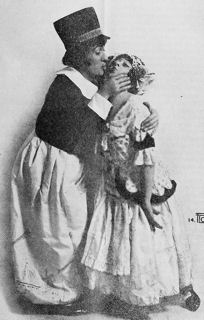 |
|
Starting out as early as 1913 as "Kolb and Harland", in 1914 - 1915 this duo presented a clever little satire entitled Evolution, 1860 - 1920 in which they showed the evolution of the dance, the minuet to the polka. On April 7. 1914 Florenz was elected to membership of "The White Rats Actors' Union". In October 1914, Florenz and Adelaide Harland asserted a copyright against Rosie Dolly and Martine Brown. The latter did, for the first time, their opening number a Dolly-Brown act in a colonial setting and dressing. Kolb and Harland did exactly the same thing after their opening act. According to witnesses identical but for Kolb and Harland the act had been running for more than a year. Eventually changed their act to "Florenz Ames and Adelaide Winthrop" in 1916. Their first prominent role was when he opened at the Cohan and Harris Theater, Broadway on June 7. 1917 in Hitchy-Koo. Under those names they had a thumbnail revue called One Minute, Please (1918) and appeared in a magazine titled Alice in Blunderland with Winthrop in the title role and Ames playing other roles. Caught in a Jamb was a amusing vehicle for clever dancing, singing, dialogue and effective costumes. Florenz and Adelaide performed this skit in Clunie-Orpheum, Sacramento as early as March 6. 1917. In October 1919 the same "new" act got a good many laughs in Keiths Colonial, Philadelphia and it was also performed in March 1920 at the Orpheum, San Francisco. October 2. 1919 Florenz and Adelaide (Feb 4. 1889 - Oct. 13 . 1923) were married in Philadelphia. Both had previously been married. Adelaide appears as Adelaide M. Buchannan on the official documents, her husband died earlier whilst Florenz was divorced from Mary earlier that same year on April 2. in New York City. They appeared together in a revue on 44th Street Theatre called Frivolities of 1920 (Jan 8. 1920 - Feb 28. 1920). The pair appeared in different vaudeville runs as “Ames & Winthrop” and toured across the U.S. performing this revue from the end of 1920 through 1921. |
|

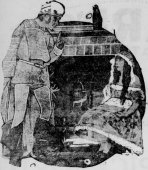 Above left: Add for "Florenz Kolb and Addie Harland, former Central Park favorites, at Orpheum Next Week" (The Allentown Democrat, Oct 16. 1915). Above right: Florenz Ames and Adelaide Winthrop, in Alice in Blunderland (Jan 1921) which headlines the New Orpheum Bill. |
|
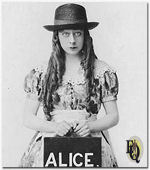 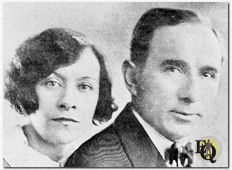 Above left: Alice ”Adelaide” Winthrop, a variety dancer as she appeared in the title role of a revue called Alice in Blunderland with her husband, Florenz Ames which brought laughs with their snappy comedy impersonations of Russian and Indian life. Above right: In 1923 he successfully teamed up with actor Eddie Dowling's wife Ray Dooley. |
|
|
The Billboard reported on March 10. 1923 that Florenz Ames left
the cast of Lady Butterfly, at the Globe Theater, New
York, we presume to care for a sick Adelaide. On October 13. 1923,
Adelaide passed away.
After his wife died Ames reappeared on Broadway in Lady Butterfly
(1923). By December 31st 1923 he was remarried to Helen Jost
in Washington D.C. For the next thirty years of his career he mainly performed as a singer and character actor in Broadway musicals. Chief comedian of the Municipal Opera Company, St. Louis for a number of seasons he was seen in The Student Prince (Municipal Theater, Forest Park, Jun 10. 1929) and gave a talk "How to create a humorous role" for the Town Club members on June 19. 1929. Helen Kolb was granted an interlocutory decree of divorce in the N.Y. Supreme Court. Mrs. Kolb alleged statutory offense with an unnamed woman at Broadway hotel, October 7. 1929. Florenz Ames returned in September 1930 after "quite a few successful production engagements" in a skit, titled What's Not, assisted by Eulahia Young and Alice O'Donnell. Early 1930 Florenz performed with Alice O'Donnell (1899 - ) in The Count of Luxembourg (Jolson's 59th Street Theatre, Feb 17. - Mar 1. 1930) on Broadway and shortly after on July 3. 1930 Florenz married Alice, his fourth wife. They made their home at 243 West End Avenue in NYC. He briefly rejoined Ray Dooley on
the East Coast in 1930. |
|
![Florenz Ames, Polly Walker, Flight Lieut C.T.P. Ulm, John Moore and Shirley Dale, taken during Lt. Ulm's visit to the Walkers, ca. 1929 [picture] Probably taken in Melbourne/ C.J. Frazer. Used by permission National Library of Australia 3930944.](images/Ames_Australia_1929.jpg) Above: Florenz Ames, Polly Walker, Flight Lieut C.T.P. Ulm, John Moore and Shirley Dale, taken during Lt. Ulm's visit to the Walkers, ca. 1929 [picture] Probably taken in Melbourne/ C.J. Frazer. Used by permission National Library of Australia 3930944. |
|
|
During 1934 and 1935 he toured Australia. Sir Benjamin Fuller's production of The Merry Malones, with Polly Walker re-creating her original Broadway role opened in Melbourne. Amongst others (120!) the cast included Florenz Ames, Alice O'Donnell (his wife), John Moore, Mss. Rene Maxwell, Leal Douglas, Shirley Dale and Bob Caperon. Back in New
York after his Australian tour (Apr 1936), Florenz
played for the first time in a straight play First Lady with
Jane Cowl in the feminine lead. A season in New York and then another on
the road. |
|
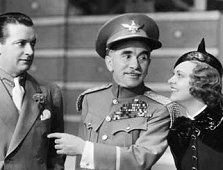
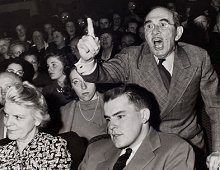 Above left: Let 'Em Eat Cake (Imperial Theatre, Oct 21. 1933 - Jan 6. 1934) Musical comedy. William Gaxton, Florenz Ames, Grace Worth. Above right: Florenz Ames in Broadway production of Mr. Big in New York (Lyceum Theatre, Sep 30. - Oct 4. 1941). |
|
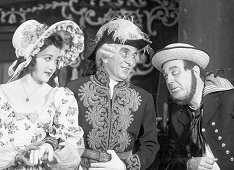
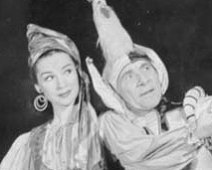 Above left: Margaret Roy, Florenz Ames, and Robert Pitkin in the Gilbert and Sullivan operetta The Pirates of Penzance (St. James Theatre, Feb 17. - Mar 14. 1942). Above right: Kathleen Roche and Florenz Ames in Gilbert & Sullivan's The Yeomen of the Gard (Ambassador Theatre, Mar 3. - 26. 1944). |
|

|
At the St. James's Theater between 1945 and 1948 Ames possibly enjoyed his longest Broadway run when he acted as replacement for the role of Andrew Carnes in Oklahoma! His final Broadway role was in a revival of Of Thee I Sing (Ziegfeld Theater, May 5. - July 5. 1952) and in which he again essayed the role of the French Ambassador. The April 1950 census still listed Alice as Florenz's wife but afterwards it is not known what happened to her or to their marriage. Between 1950 to 1958 he had many other roles in both film and television. Ames appeared alongside some of the biggest names in 1950s Hollywood: Grace Kelly, Robert Mitchum, Barry Sullivan, Marlon Brando, Anthony Quinn, Glenn Ford, Greer Garson, Doris Day, to name a few. From 1950 to 1956, he played the role of Inspector Richard Queen in the first televised versions of Ellery Queen, sharing star billing with Lee Bowman, who played Ellery (below left). Florenz Ames, was sixty-six when he took the part. Like Ralph Bellamy, he held down a Broadway role which he would race to every night after rehearsal or the weekly broadcast. When this series is remembered, it is usually Ames who is recalled. There were probably two reasons for this. One, the TV Ellery was unequivocally bland. And two, Ames remained while various Ellerys came and went. |
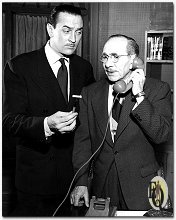 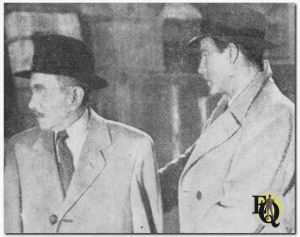 Above left: Florenz as Inspector Richard Queen in the first televised version of Ellery Queen, with Lee Bowman, who played Ellery . Above right: Florenz Ames (left) as Inspector Queen, and Hugh Marlowe as Ellery Queen in a tense moment from one of the thrilling episodes of Mystery is My Business. This episode is entitled "Mardi Gras". |
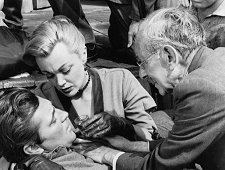
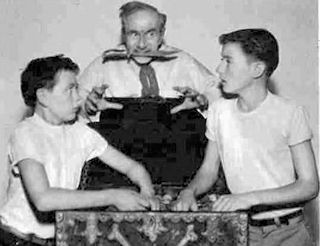 Above left: Robert Mitchum, Jan Sterling, Florenz Ames (as Doc Hughes) in the Western Man with the Gun (United Artists, Oct 27. 1955) Above right: Tommy Kirk (left), Florenz Ames (center), and Tim Considine in The Hardy Boys: The Mystery of the Applegate Treasure (1956). |
| From October 1. 1956 Florenz Ames appeared in one of the first serialized stories on Walt Disney’s Mickey Mouse Club, prancing around waving cutlasses as old man Silas Applegate in The Hardy Boys: The Mystery of the Applegate Treasure (in 16 of 19 episodes, Oct 4. - 26. 1956). He also had a brief appearance in the second Hardy Boys serial produced by Disney. Those 15 episodes of The Hardy Boys: The Mystery of the Ghost Farm were broadcast between September 13. and December 20. 1957. |
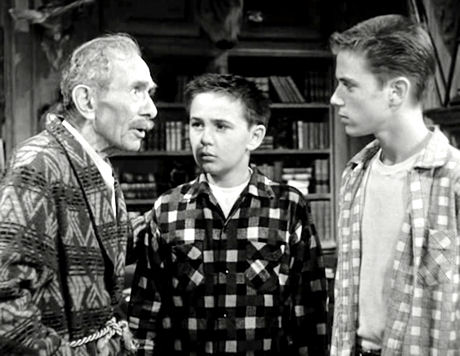
 Above: Florenz Ames in The Hardy Boys: The Mystery of the Applegate Treasure (ABC, 1956) with Tim Considine and Tommy Kirk. |
| Florenz is possibly best known as Mr. Dithers (24 episodes, Jan 4. - Jul 28. 1957) in the short-lived (but perpetually rerun) Blondie series (NBC, Jan 4. - Sep 27. 1957). This show, retelling stories and situations familiar to readers of the comic strip, lasted one year. |
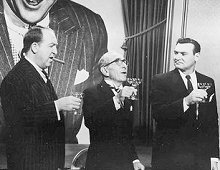
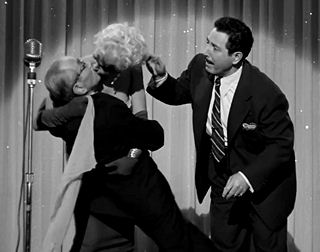 Above left: Jesse White, Florenz Ames and Frankie Laine in He Laughed Last (Columbia, Aug 12. 1956). Above right: Florenz (as Mr. Julius Dithers) is swept of his feet when the Glamour Girl (Barbara Nichols) gets hold of him in an episode of Blondie (NBC, Apr 5. 1957). Harold Peary watches closely. |
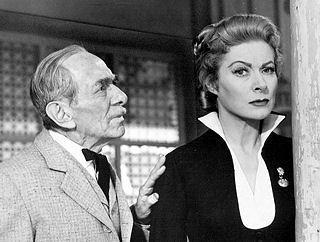
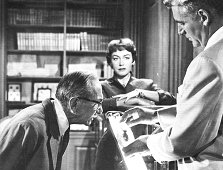 Above left: Florenz played Barber in 3 episodes of TV's Telephone Time (CBS/ABC, Apr 15. 1956 - Sep 10. 1957, min.3) seen here in 1957 playing opposite Greer Garson. Above right: Florenz as Prof. Anton Gunther in The Deadly Mantis (Universal, May 1. 1957). |
|
When interviewed in July 1956 Ames was asked about his earlier movie work and his absence from films before his career was reinvigorated. He explained his earlier efforts quite plainly: "I saw myself for a nickel and tried afterwards to get a refund because it was that bad." Ames went on: "The late Sidney Olcott, who directed George M.Cohan and me in 'Seven Keys to Baldpate' used to wander up and down Broadway begging passersby to work in his pictures for five dollars a day and free lunch". Florenz passed away February 11. 1958 in East Islip, Suffolk County, New York. (7) He was last seen on film in Teacher's Pet (Pearlberg Seaton, Apr 1. 1958) a movie with Clark Gable and Doris Day. On TV that honor was for "Welcome to Washington" a Colgate Theatre episode (NBC, Sep 30. 1958). |
| Thanks to Dale C. Andrews |
|
Notes: * Jan. 6. 1883 according to his 1918 draft registration as do many other official documents as of then. The 1900 census indicates Aug. 1883 in Germany and US citizenship in 1890. ** Some sources give well-known producer Winthrop Ames as his brother but this is incorrect. All dates for movies are for the first US release. All dates for TV programs are original first airdates. All dates for (radio) plays are for the time span the actor was involved. Facts in red still need confirmation. |
|
Click on Uncle Sam if you think you can help out...!
|
|
Other references (1) Encyclopedia of Early Television Crime Fighters - Everett Aaker (2) Wikipedia.fr (3) IMDb (4) IBDB and IBDB (5) National Library of Australia: Portrait of Florenz Ames, Polly Walker, Charles Ulm, John Moore and Shirley Dale at a theatre, ca. 1929 Author: C.J. Frazer. Used by Permission (6) Radiogoldindex (7) New York State Health Department, Death Index, 1957 - 1963 (for Florence S. Kolb) (8) Playbill.com (9) Spectra - IOBDB Additional video & audio sources (1) Full photomystery The Adventures of Ellery Queen episode: The Twilight Zone (2) The Mystery of the Appelgate Treasure, Video Clip (3) Facebook pages dedicated to Florenz Ames (4) Blondie "The Kiss Clip" from the episode "The Glamour Girl" (1957) (5) That's What I Told Him Last Night 30 sec clip from the Florenz Ames song from "Arms and the Girl" (Feb 2. - May 27. 1950) |
|
This actor profile is a part of
Ellery Queen a website on deduction.
The actor above played Richard Queen in
an
Ellery Queen TV series.
Click Uncle Sam if you think you can help
out...! Many of the profiles on this site have been compiled after very careful research of various sources. Please quote and cite ethically! |
|
Page first published on May 16. 2016 Version x2.1 - Last updated April 23. 2025 |
 b a c k
t o L i s t o f S u s p
e c t s
b a c k
t o L i s t o f S u s p
e c t s
|
|
| Introduction | Floor Plan | Q.B.I. |
List of Suspects | Whodunit? | Q.E.D. | Kill as directed | New | Copyright Copyright © MCMXCIX-MMXXV Ellery Queen, a website on deduction. All rights reserved. |